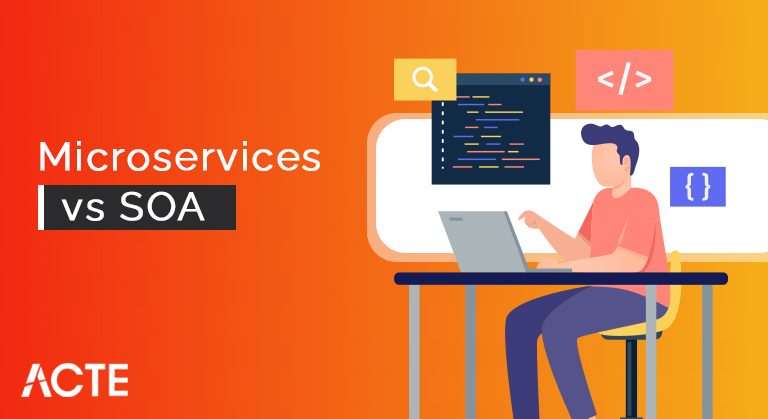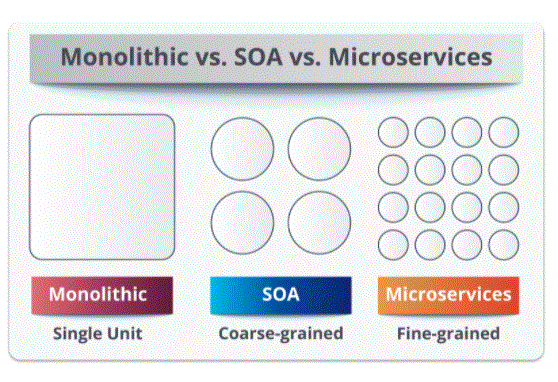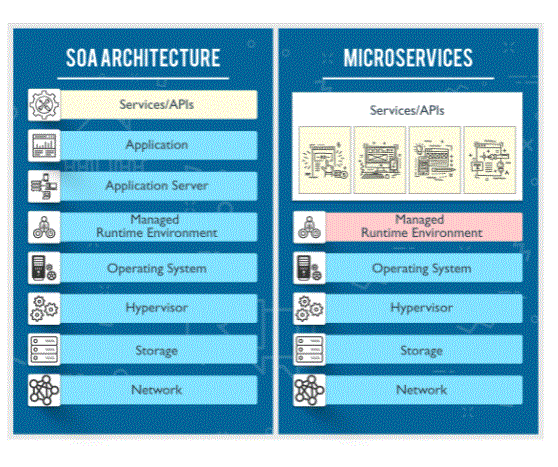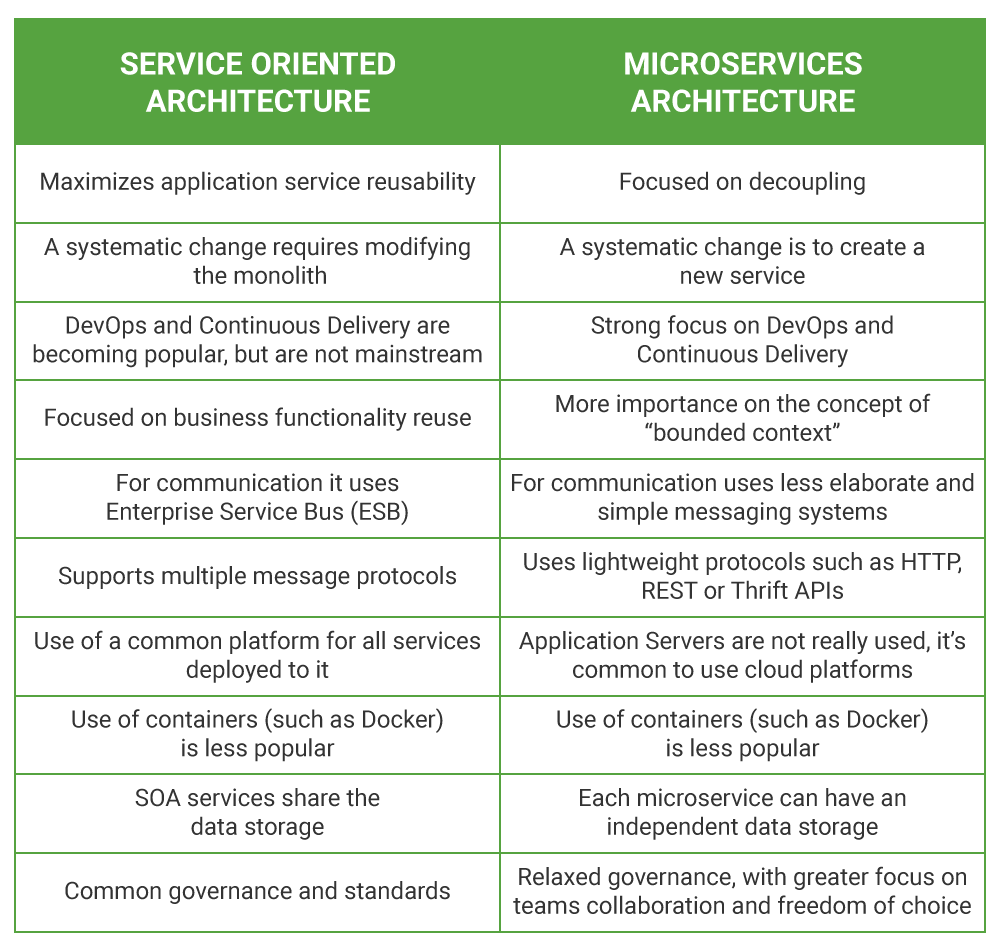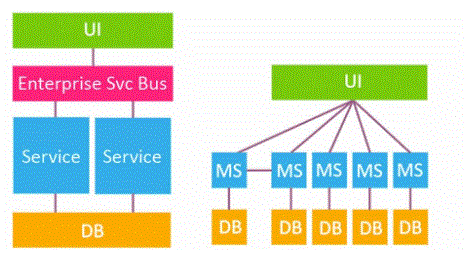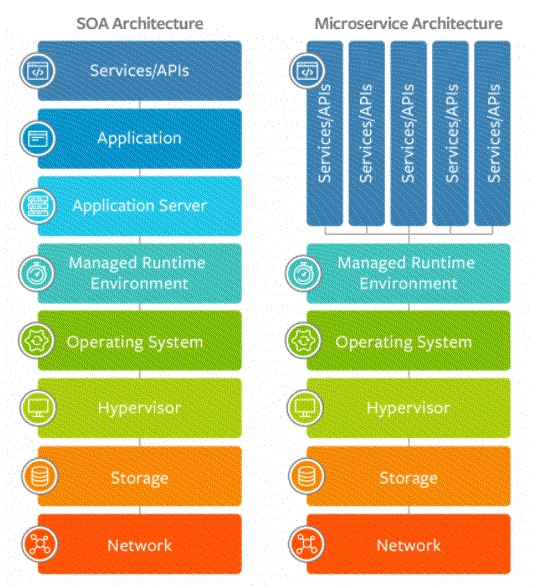Microservices vs SOA | Know Their Differences and Which Should You Learn?
Last updated on
27th Dec 2021, Blog, General
 (5.0) | 19476 Ratings
1325
(5.0) | 19476 Ratings
1325
To put it simply, service-oriented architecture (SOA) has an enterprise scope, while the microservices architecture has an application scope. Many of the core principles of each approach become incompatible when you neglect this difference.
- What is SOA?
- What is Microservices?
- What is SOA Architecture?
- What is a Microservice Architecture?
- Features of SOA & Microservices
- Microservices vs SOA: What’s the Difference?
- Advantages of SOA & Microservices
- Disadvantage of SOA & Microservices
- Which Architecture is Better?
- Conclusion
What is the meaning of SOA?
SOA stands for “Service-Oriented Architecture.” It is an architectural style and approach to software design that promotes the concept of creating applications by using loosely coupled, interoperable, and reusable services. SOA is not limited to a single technology. or programming language but is a set of principles and guidelines for designing distributed systems.
Key features and concepts of SOA include:
Services: Services are self-contained units of functionality that can be accessed over a network. They represent specific business capabilities and can be combined to build complex applications. Services are designed to be independent and reusable.
Loose Coupling: Services in an SOA are loosely coupled, meaning they can be developed, maintained, and deployed independently of each other. Changes to one service do not affect others as long as the contract (interface) remains intact.
Interoperability: Services in an SOA communicate using standardized protocols and data formats, enabling different systems, platforms, and programming languages to communicate with one another in real time.
Reusability: The modular nature of services in SOA allows them to be reused across different applications and business processes, leading to increased development efficiency and reduced duplication of effort.
Service Contract: Each service in SOA defines a contract, which specifies the interface and behavior of the service. The contract acts as a formal agreement between the service provider and service consumer.
Service Registry: An SOA may include a service registry where services are published, discovered, and managed. The registry acts as a central repository of service metadata and helps in locating and using services.
Statelessness: Services in SOA are often designed to be stateless, meaning they do not store any client-specific data between requests. This promotes scalability and simplifies service management.
Business Processes: SOA allows the composition of services into higher-level business processes or workflows. These processes can be designed to achieve specific business objectives by orchestrating the services in a coordinated manner.
Enterprise Integration: SOA is commonly used for enterprise application integration (EAI) to enable seamless communication and data exchange between different applications and systems within an organization.
Benefits of Microservices
Microservices offer numerous benefits to organizations and software development teams. Some of the key advantages of adopting a microservices architecture include:
Scalability: Microservices allow individual services to be independently scaled based on their specific workload. This granularity of scaling enables better resource utilization and ensures that only the necessary components are scaled up or down, leading to improved performance and cost efficiency.
Flexibility and Agility: Microservices promote a modular and loosely coupled design, enabling faster development cycles and easier deployment of new features. Teams can work on individual services independently, reducing coordination overhead and enabling continuous delivery practices.
Independent Development and Deployment: Each microservice can be developed, tested, and deployed independently. This allows for quicker updates, bug fixes, and feature enhancements without the need to redeploy the entire application.
Technology Diversity: Microservices architecture allows teams to choose the best-suited technology stack for each service. This freedom to use different programming languages, frameworks, and databases helps optimize solutions for specific use cases.
Fault Isolation: Failures in one microservice are less likely to propagate to other services due to the isolated nature of microservices. This fault isolation improves the overall robustness and resilience of the system.
Reusability and Modularity: Microservices promote the development of small, focused, and reusable services. These services can be combined to build different applications, reducing development effort and speeding up time-to-market for new products.
Continuous Deployment: The independent nature of microservices enables continuous deployment and continuous integration practices. Automated testing and deployment pipelines can be set up for individual services, facilitating faster and safer releases.
Team Autonomy: Microservices architecture allows different development teams to work independently on their respective services. This autonomy empowers teams to make their own technology decisions and iterate rapidly.
Improved Developer Productivity: Smaller codebases and focused responsibilities within microservices make it easier for developers to understand, maintain, and troubleshoot the system. This leads to increased developer productivity and reduced time spent on debugging and code refactoring.
Business Agility: Microservices’ ability to quickly adapt to changing business needs and rapidly release new features allows businesses to respond quickly to market demands and stay ahead of the competition.
Benefits of Service-Oriented Architecture (SOA)
Reusability: SOA promotes the creation of reusable services that can be shared across multiple applications and business processes. This reusability reduces development effort, minimizes duplication of code, and increases overall development efficiency.
Interoperability: Services in SOA communicate using standardized protocols and data formats, enabling seamless integration and interaction between different systems and technologies. This interoperability allows for the integration of diverse applications, regardless of their underlying technologies or platforms.
Flexibility and Agility: SOA’s modular and loosely coupled nature allows organizations to respond quickly to changing business requirements. Adding, modifying, or replacing services is relatively easier, enabling faster development and deployment cycles.
Scalability: Since SOA is dispersed, individual services can be scaled independently based on their workload. This flexibility enables better resource utilization and ensures that the entire system can handle varying levels of traffic and demand.
Business Alignment: SOA is designed to align closely with business capabilities. Each service represents a specific business function, making it easier for development teams to understand, design, and maintain the codebase according to business requirements.
Lower Maintenance Costs: SOA’s modular design and loose coupling reduce the impact of changes to one service on other services. This isolation of services makes it easier to update and maintain individual components without affecting the entire system.
Improved Security: SOA supports standardized security features like WS-Security, which allows for the integration of various security protocols and standards, such as XML Encryption and XML Signature. This helps in implementing consistent and robust security measures across services.
Reduced Technology Lock-In: SOA’s focus on standard protocols and interfaces enables organizations to use different technologies for different services. This reduces the risk of being locked into a specific technology stack and provides the freedom to adopt newer technologies when needed.
Business Process Orchestration: SOA enables the orchestration of services to create higher-level business processes. These orchestrated processes can be designed to achieve specific business objectives by coordinating the interactions between services.
Legacy System Integration: SOA is often used for integrating legacy systems with modern applications. By encapsulating legacy functionalities as services, organizations can expose these functionalities to new applications without having to rewrite or replace the entire legacy system.
What is mean by Microservices
Microservices is a software design architectural style. where applications are structured as a collection of small, independent, and loosely coupled services. Each service represents a specific business capability and runs as a separate process, communicating with other services over a network, typically through APIs (Application Programming Interfaces).
Key characteristics of microservices:
Small and Autonomous: Each microservice is small and focused on a single business function. It is designed to be autonomous, meaning it can be developed, deployed, and scaled independently without affecting other services.
Decentralized Governance: Microservices promote decentralized decision-making and governance. Different teams or development groups can work on individual services, allowing for faster development and deployment cycles.
Communication via APIs: Microservices interact with each other using well-defined APIs. Services expose their functionality through APIs, enabling them to be accessed and combined to build complex applications.
Loosely Coupled: Microservices are loosely coupled, meaning they are not dependent on the internal details of other services. Changes to one service should not have a significant impact on other services, as long as the API contract remains unchanged.
Polyglot Architecture: Microservices allow developers to use different technologies and programming languages for different services. This flexibility allows teams to choose the best tools for the specific requirements of each service.
Scalability and Resilience: Microservices can be individually scaled based on their specific workload, allowing for better resource utilization and responsiveness. Additionally, if one service fails, it should not bring down the entire system, as other services can continue to operate.
Continuous Deployment: Microservices are well-suited for continuous deployment and continuous integration practices. Each service can be independently tested, built, and deployed, leading to faster development cycles.
Fault Isolation: With microservices, failures in one service are less likely to propagate to other services due to their isolated nature. This improves fault tolerance and system stability.
Focus on Business Capabilities: Microservices are designed to align closely with business capabilities. Each service focuses on a specific business domain, which makes it easier to understand and maintain the codebase.
SOA Sample Resumes! Download & Edit, Get Noticed by Top Employers!
Download
Conclusion:
- SOA focuses on application service reusability, while microservices focuses more on decoupling.
- SOA is monolithic in nature whereas microservices is full-stack.
- SOA applications are built to perform multiple business functions, but microservices are built to perform a single business function.
- SOA involves sharing of data storage between services whereas in microservices, each service can have independent data storage.
- SOA is designed to share resources across services whereas microservices are designed to host services that can function independently.
- In SOA architecture, DevOps and Continuous Delivery are becoming popular but not yet mainstream, while Microservices has a strong emphasis on DevOps and Continuous Delivery.
- SOA is a less scalable architecture whereas Microservices is a highly scalable architecture.
